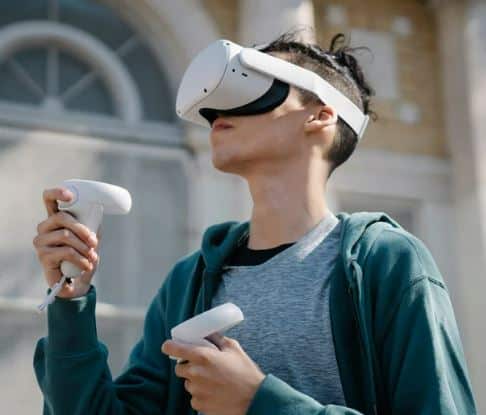I have been told that it is rude to ask people what they do for a living in Italy. I know that seems like a strange way to start a blog about vestibular disorders, but hang in here with me for a minute. I just got back from a week-long vacation visiting friends at their lake house in Michigan. I had the opportunity to meet many of their very nice neighbors, and was reminded how it is almost expected in the United States to answer the question, “So, what do you do for a living?” in the first few minutes of casual social conversation.
Most people are just making polite conversation and looking for something in common to talk about. I noticed that the most common response to “I specialize in inner ear disorders, you know, vertigo, dizziness and such.” Is “Oh, I get motion sickness (or seasickness, etc. etc.). That puts me in the awkward position of having to respond. I could say, “My, this certainly is some tasty cheese dip,” or I could say, “Oh, motion sickness usually is not caused by an inner ear disorder.”
Which do you think would make my new acquaintance feel more at ease?
Motion Sickness – Sensory Mismatch
Motion sickness is thought to occur due to a sensory mismatch between the inner ear, visual input, and the proprioceptive system. When experiencing motion, such as being on a moving boat, the inner ear detects movement, while visual cues may contradict this sensation.
This sensory conflict leads to feelings of nausea, which serve as a natural warning that the balance system is temporarily unreliable. The resulting discomfort often encourages affected individuals to seek stillness to prevent potential harm.
Motion sickness is essentially a result of conflicting sensory information, where the inner ear, visual input, and proprioceptive system (the sense of body position and movement) do not align, leading to feelings of nausea as a warning sign of temporary balance system unreliability.
The reasons behind why some individuals are prone to motion sickness while others are not remain a mystery. However, there is evidence to suggest that individuals who experience migraines are more susceptible to motion sickness.
This suggests that certain individuals may possess brains that are more adept at managing sensory conflicts, thus reducing the likelihood of experiencing motion sickness symptoms.
We discuss Sensory Conflicts in more detail here.
Virtual Reality Sickness – A Growing Problem

As VR adoption grows, the need to address VR sickness has become a bigger issue
Virtual reality (VR) is growing in popularity and this has put a growing interest on VR related motion sickness, also known as cybersickness. Symptoms include nausea, headaches, and dizziness. The main reason people experience motion sickness in VR is due to a disconnect between what the brain perceives as movement and the body’s actual static position. This confusion can lead to discomfort and illness.
While the severity of symptoms varies from person to person, there are strategies to mitigate and prevent VR motion sickness.
To avoid VR motion sickness, it is recommended to limit the duration of your VR sessions. Prolonged exposure to VR increases the risk of experiencing motion sickness. Gradually building up your tolerance by starting with shorter gaming periods and gradually extending them can help your brain adapt to the conflicting signals it receives. This approach, known as developing your “VR legs,” trains your brain to ignore some of the discomfort and allows you to spend more time in VR without issues.
Choosing the right games and movement methods can also make a difference. Opting for games that minimize movement or offer teleportation instead of continuous walking can reduce the chances of motion sickness. Some games provide settings to darken screen edges, which helps alleviate discomfort during movement. Additionally, ensuring your VR headset is properly fitted and adjusting the eye distance between lenses can lessen the load on your brain and contribute to a more comfortable experience. Paying attention to breathing and maintaining a comfortable room temperature, such as using a fan during sessions, can also help prevent motion sickness symptoms.
“VR motion sickness can be mitigated by gradually building up your tolerance and choosing games that minimize movement or offer teleportation. Optimizing your headset setup and paying attention to factors like breathing and temperature can further enhance the comfort of your VR experience.”
VR motion sickness occurs due to the brain-body disconnect caused by virtual movement. By gradually increasing exposure time, choosing appropriate games, optimizing headset setup, and considering factors like breathing and temperature, it may be possible to alleviate or avoid VR motion sickness. These strategies can enhance the overall enjoyment of virtual reality experiences.
About the author
 Alan Desmond, AuD, is the director of the Balance Disorders Program at Wake Forest Baptist Health Center, and holds an adjunct assistant professor faculty position at the Wake Forest School of Medicine. He has written several books and book chapters on balance disorders and vestibular function. He is the co-author of the Clinical Practice Guideline for Benign Paroxysmal Positional Vertigo (BPPV). In 2015, he was the recipient of the President’s Award from the American Academy of Audiology.
Alan Desmond, AuD, is the director of the Balance Disorders Program at Wake Forest Baptist Health Center, and holds an adjunct assistant professor faculty position at the Wake Forest School of Medicine. He has written several books and book chapters on balance disorders and vestibular function. He is the co-author of the Clinical Practice Guideline for Benign Paroxysmal Positional Vertigo (BPPV). In 2015, he was the recipient of the President’s Award from the American Academy of Audiology.
**this piece has been updated for clarity. It originally published on July 20, 2013







So would you say, therefore, that vestibular patients are more prone to motion sickness?
Good question. The answer is, “It depends.” Studies have shown that Meniere’s and Migraine patients may have a greater tendency towards motion sickness. Theoretically, patients with stable but reduced vestibular function, such a post neuritis or ototoxicity may be less prone to motion intolerance. I will do a blog about this. Check back in a few weeks.